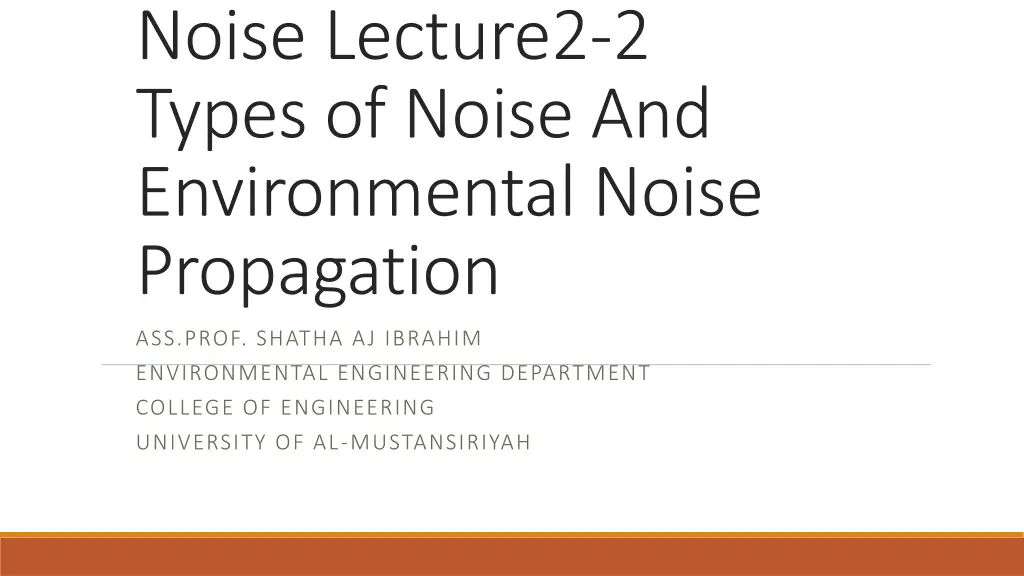
Types of Noise Sources and Propagation Characteristics
Learn about different types of noise sources such as point sources and line sources, and how environmental factors like wind and temperature affect the propagation of noise. Understand how to calculate sound pressure levels at varying distances from noise sources based on their characteristics.
Download Presentation

Please find below an Image/Link to download the presentation.
The content on the website is provided AS IS for your information and personal use only. It may not be sold, licensed, or shared on other websites without obtaining consent from the author. If you encounter any issues during the download, it is possible that the publisher has removed the file from their server.
You are allowed to download the files provided on this website for personal or commercial use, subject to the condition that they are used lawfully. All files are the property of their respective owners.
The content on the website is provided AS IS for your information and personal use only. It may not be sold, licensed, or shared on other websites without obtaining consent from the author.
E N D
Presentation Transcript
Noise Lecture2-2 Types of Noise And Environmental Noise Propagation ASS.PROF. SHATHA AJ IBRAHIM ENVIRONMENTAL ENGINEERING DEPARTMENT COLLEGE OF ENGINEERING UNIVERSITY OF AL-MUSTANSIRIYAH
1-Point source If the dimensions of a noise source are small compared with the distance to the listener, it is called a point source, for example, fans and chimney stacks. The sound energy spreads out spherically, so that the sound pressure level is the same for all points at the same distance from the source, and decreases by 6 dB per doubling of distance. This holds true until ground and air attenuation noticeably affect the level. For a point source with sound power level (LW) , located near the ground, the sound pressure level (Lp) at any distance (r, in m) from that source can be calculated from the equation: Lp = LW 20log10 (r) 8 dB ???1 ???2= 20??? ?2 ?1 r1 r2 r
2-Line Source If a noise source is narrow in one direction and long in the other compared to the distance to the listener, it is called a line source. It can be a single source such as a long pipe carrying a turbulent fluid, or it can be composed of many point sources operating simultaneously, such as a stream of vehicles on a busy road. The sound level spreads out cylindrically, so the sound pressure level is the same at all points at the same distance from the line, and decreases by 3 dB per doubling of distance. This holds true until ground and air attenuation noticeably affect the level. For a line source with sound power level per meter (LW/m) located near the ground, the sound pressure level (Lp) at any distance (r, in m) from that source can be calculated from the equation: Lp = LW 10log10 (r) 5 dB ???1 ???2= 10??? ?2 ?1 r2 r1
Wind and Temperature Wind speed increases with altitude, which will bend the path of sound to focus it on the downwind side and make a shadow on the upwind side of the source. Why Measure Downwind? At short distances, up to 50 m, the wind has minor influence on the measured sound level. For longer distances, the wind effect becomes appreciably greater. Downwind, the level may increase by a few dB, depending on wind speed. But measuring upwind or side- wind, the level can drop by over 20 dB, depending on wind speed and distance. This is why downwind measurement is preferred the deviation is smaller and the result is also conservative.
Temperature Temperature gradients create effects similar to those of wind gradients, except that they are uniform in all directions from the source. On a sunny day with no wind, temperature decreases with altitude, giving a shadow effect for sound. On a clear night, temperature may increase with altitude (temperature inversion), focusing sound on the ground surface. During day, the layers of air near the ground is warmer than the layers of air higher up. Air layer near the ground is less dense. Therefore, sound wave is bent toward the normal. At night, the layers of air near the ground is cool faster than the layers of air higher up. Air layer near the ground is denser. Sound travels faster in warm air than in cool air resulting increasing of wavelength. When the angle of incidence is larger than the critical angle, total internal reflection occurs. Therefore, the path of the sound curves reflects downwards and you can hear the sound easily at night
Ground Effects Sound reflected by the ground interferes with the directly propagated sound. The effect of the ground is different for acoustically hard (e.g., concrete or water), soft (e.g., grass, trees or vegetation) and mixed surfaces. Ground attenuation is often calculated in frequency bands to take into account the frequency content of the noise source and the type of ground between the source and the receiver. Precipitation can affect ground attenuation. Snow, for example, can give considerable attenuation, and can also cause high, positive temperature gradients. Regulations often advise against measuring under such conditions.






















